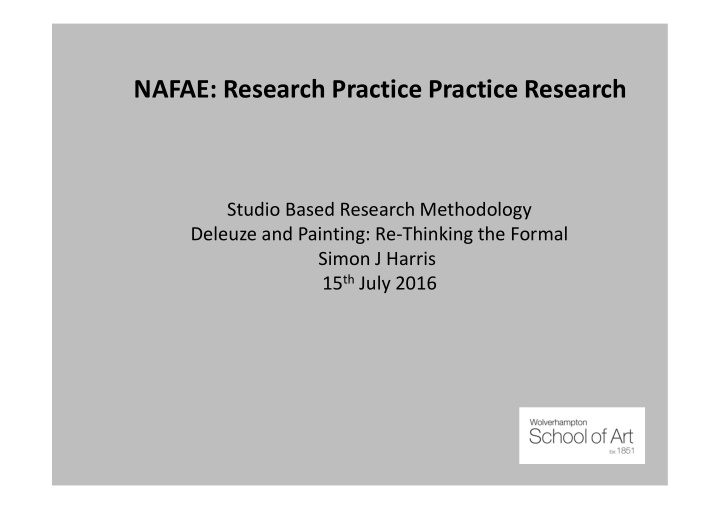



NAFAE: Research Practice Practice Research Studio Based Research Methodology Deleuze and Painting: Re-Thinking the Formal Simon J Harris 15 th July 2016
Scopic Regimes. The initial aim of my research developed out of an interest in what appeared to be a clear binary opposition between the structure and understanding of the picture plane within abstract and figurative painting. I was interested in this ‘choice’ of space based on genre and whether there was potential to find something new in painting between these two apparently opposing poles.
b x A b
Diego Velasquez (1665) Las Meninas
B A x B A
Jackson Pollock (1949) Out of the Web
A b x A b
Yves Klein (1962) IKB191
A b x A A b
Carla Klein (2013 -14) Untitled
Micheal Raedecker (2007) Insignificance
Surface as focal slice
Surface as retina
The heightened sensitivity of the picture plane may no longer permit sculptural illusion, or trompe-l ’ oeil , but it does and must permit optical illusion. The first mark made on a surface destroys its virtual flatness, and the configurations of a Mondrian still suggest a kind of illusion of a third dimension. Where the Old Masters created an illusion of space into which one could imagine oneself walking, the illusion created by a Modernist is one into which one can only look, can only travel through only with the eye. (Greenberg 1965, p.777) Greenberg, Clement. (1965) Modernist Painting in Art in Theory 1900-2000 (Ed. By Charles Harrison and Paul Wood, (Blackwell Publishing. 2003)
The viewer discovers that he or she has a body that supports this gaze, a body with feet that hurt or a back that aches, and that the picture, also embodied, is poorly lit so that its frame casts a distracting shadow over its surface now perceived as glassy with too much varnish. What Clem refers to as “the ‘full meaning’ of a picture—i.e., its aesthetic fact” drains out of this situation, relocated as it is in the all too real. And the result is that instead of generating an “aesthetic fact, ” the picture, now reified, simply returns the look, merely gazing “blankly” back at you. Krauss, R. (1997) The Optical Unconscious . Massachusetts Institute of Technology.
Investigative methodology:
Investigative methodology: Which develops key concepts from Deleuze’s philosophical writings as methods within the studio. • The Fold • Smooth and Striated space in relation to Beauty and Sublime • The Monad and Nomad • The Figural • The Virtual
Most of all, the reader is invited to lift a dynamism out of the book entirely, and incarnate it in a foreign medium, whether it be painting or politics. The authors steal from other disciplines with glee, but they are more than happy to return the favour. Deleuze’s own image for a concept is not a brick, but a “tool box”. The question is not: is it true? But: does it work? What new thoughts does it make it possible to feel? What new sensations and perceptions does it open in the body? (Massumi in Deleuze & Guattari, 2004, p.xv- xvi) Deleuze, G. and Guattari, F. (2004) A Thousand Plateaus . London: Continuum .
Suppertime Oil on canvas, 122 x 122 cm 2005
Suppertime Oil on canvas, 244 x 244 cm 2006
In short, the area of plain, uniform color vibrates, clenches or cracks open because it is bearer of glimpsed forces. And this, first of all, is what makes painting abstract: summoning forces, populating the area of plain, uniform color with the forces it bears, making the invisible forces visible in themselves, drawing up figures with a geometrical appearance… (Deleuze and Guattari, 1994, p.181-2) Deleuze, G. and Guattari, F. (1994) What Is Philosophy? London: Verso
The Curious pigmentation of the pearl Oil on canvas, 134 x 94 cm 2008
The Little Street Oil on canvas, 244 x 230 cm 2010
In this regard, the same criticism can be made against both figurative painting and abstract painting: they pass through the brain, they do not act directly upon the nervous system, they do not attain the sensation, they do not liberate the Figure – all because they remain at one and the same level . (Deleuze, 2005c, p.26) Deleuze, G. (2005c) Francis Bacon: The Logic of Sensation . London: Continuum Books.
Virtually Celluloid Oil on canvas, 94 x 134 cm 2013
Baroque is abstract art par excellence: on the lower floor, flush with the ground, within reach, the art comprehends the textures of matter…But abstraction is not the negation of form: it posits form as folded, existing only as a ‘mental landscape’ in the soul or in the mind, in upper altitudes; hence it also includes immaterial folds. (Deleuze, 2006a, p.40). Deleuze, G. (2006a) The Fold - Leibniz and the Baroque . London: The Athlone Press.
Something about now: Now about something Oil on canvas, 134 x 94 cm 2015
International Favourite Filter Oil on canvas, 152 x 76 cm 2016
Recommend
More recommend